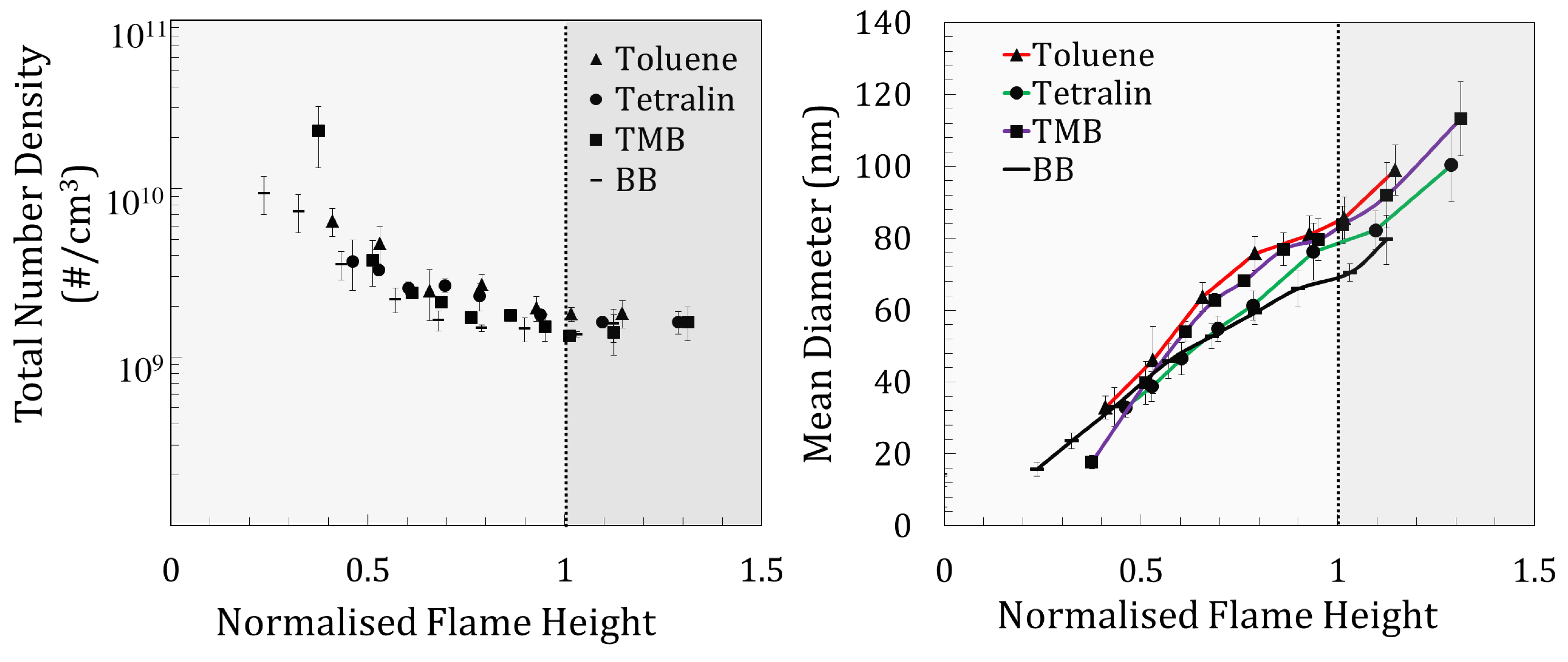Technical Report 140, c4e-Preprint Series, Cambridge
Sooting tendency of surrogates for the aromatic fractions of diesel and gasoline in a wick-fed diffusion flame
Reference: Technical Report 140, c4e-Preprint Series, Cambridge, 2014
- Particle size distributions of several aromatic hydrocarbons in a diffusion flame were measured.
- At the smoke point all fuels exhibited similar mean soot particle diameter.
- Aromatic fuels substituted with larger aliphatic chains produce particles with smaller mean diameters.
 The sooting characteristics of pure aromatic fuels representative of those present in commercial fuels were studied. The experiment involves the non-premixed combustion of the fuel in wick-fed burner. The particle size distributions (PSD) of soot particles were measured at the tip of flames of different heights, using a differential mobility spectrometer (DMS). Substituted aromatics were studied in order to capture the influence of their structure in the final PSD. At the smallest flame height the PSD is bimodal without a strong prevalence of neither the nucleation or coagulation mode, except for trimethylbenze (TMB) that exhibits a large nucleation mode. For
larger flame heights the PSD is multimodal, and the coagulation mode enlarges and shifts to larger particle diameters. After the smoke point the PSD presents a single mode of particles with sizes of about 100nm. Around the smoke point, all fuels show a slight slow down in particle growth probably due to stronger oxidation while the tip
is changing from a close defined one to an opened soot trail. Toluene, TMB produced the largest soot particles, tetralin, butylbenzene (BB) and phenylcyclohexane (PCH) the lowest. This evidence indicates that aromatics substituted with larger aliphatics tend to produce smaller soot particles.
The sooting characteristics of pure aromatic fuels representative of those present in commercial fuels were studied. The experiment involves the non-premixed combustion of the fuel in wick-fed burner. The particle size distributions (PSD) of soot particles were measured at the tip of flames of different heights, using a differential mobility spectrometer (DMS). Substituted aromatics were studied in order to capture the influence of their structure in the final PSD. At the smallest flame height the PSD is bimodal without a strong prevalence of neither the nucleation or coagulation mode, except for trimethylbenze (TMB) that exhibits a large nucleation mode. For
larger flame heights the PSD is multimodal, and the coagulation mode enlarges and shifts to larger particle diameters. After the smoke point the PSD presents a single mode of particles with sizes of about 100nm. Around the smoke point, all fuels show a slight slow down in particle growth probably due to stronger oxidation while the tip
is changing from a close defined one to an opened soot trail. Toluene, TMB produced the largest soot particles, tetralin, butylbenzene (BB) and phenylcyclohexane (PCH) the lowest. This evidence indicates that aromatics substituted with larger aliphatics tend to produce smaller soot particles.
Material from this preprint has been published in Fuel.
PDF (719.5 KB)



